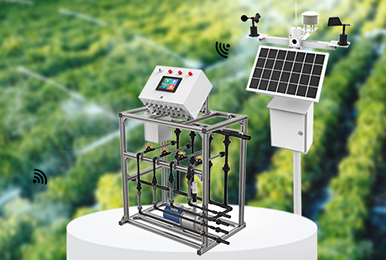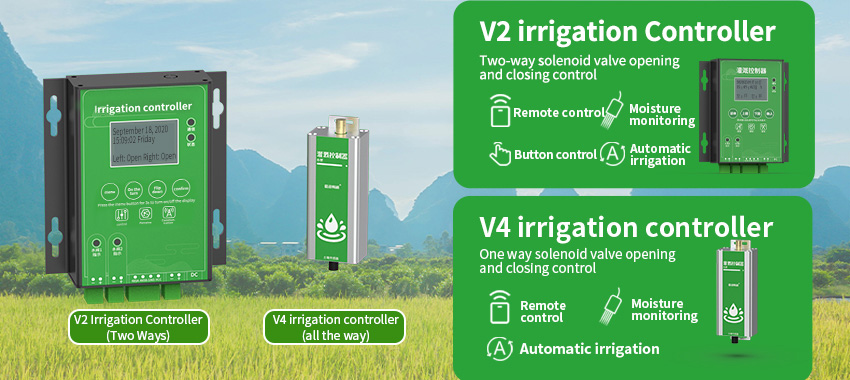background:
Although the existing water-saving irrigation system has obvious effects on reducing the cost of crop irrigation and improving the crop yield. However, the rationality of irrigation cannot be effectively implemented due to many problems to be solved in the conventional drip irrigation system. The main problem: the randomness of manual operation is too large, and the irrigation system cannot be strictly implemented. Empirical irrigation cannot guarantee the uniformity of irrigation. All manual operation, the workload is large, and the labor force cannot be liberated. We can use agricultural automation irrigation equipment to assist.
my country’s agricultural water consumption accounts for about 80% of the total water consumption. Due to the generally low efficiency of agricultural irrigation, the water utilization rate is only 45%. The countries with high water utilization rate have reached 70% to 80%. Therefore, solving the problem of agricultural irrigation water is very important for alleviating the shortage of water resources.

The role of using irrigation equipment:
Agricultural water metered irrigation improves the accuracy of metering management, and gradually straightens out the rational distribution of flow between upper and lower channels. Strengthen water management efforts to prevent water leakage. Reduce and reduce the loss of channel water delivery, for scientific scheduling, rational water distribution. Realize precise irrigation, timely irrigation, and liberate labor. To develop high-efficiency agriculture, Jingxun has developed a water-saving irrigation automation control system. Real-time monitoring of soil moisture and crop growth, and monitoring and forecasting of irrigation water in irrigation areas. Implement intelligent water-saving irrigation and integrated management of water and fertilizer.
Soil temperature and humidity monitoring:
The LoRa wireless temperature and humidity sensor collection terminal monitors the soil temperature and humidity, and the system automatically determines whether to start automatic irrigation according to the soil temperature and humidity system. The system determines that the soil temperature and humidity reach the threshold of automatic automatic irrigation, and the electronic valve is automatically opened to start automatic irrigation. When the temperature and humidity reach the standard value, the solenoid valve is automatically closed and the irrigation stops.
Soil Moisture:
Soil conductivity, soil PH value, groundwater level, groundwater quality, air temperature, air humidity, light intensity, wind speed and direction, rainfall and other information can comprehensively, scientifically and truly reflect the soil changes in the monitored area. The soil moisture status of each monitoring point can be provided timely and accurately. It provides important basic information for disaster reduction and drought relief. Sensors collect soil moisture information, weather information and crop growth conditions. Real-time remote monitoring of farmland irrigation water consumption through wireless network. The operation of irrigation and nutrient supply is carried out according to the needs of crops.
Introduction to irrigation control:
Send the command to the data acquisition control module through the wireless transmission module to control the opening or closing of the solenoid valve; automatic irrigation function: according to the different water requirements of different regions and different crops at different growth stages, set the corresponding parameters, when the value When it falls below or exceeds a certain range, the irrigation function is automatically turned on. Automatic nutrient replenishment function: In soilless culture, according to the different nutrient requirements of different crops at different growth stages, the corresponding parameters are set. When the value is lower than or beyond a certain range, the corresponding nutrients are automatically replenished.

Irrigation controller:
The irrigation controller can realize the control of the irrigation solenoid valve and the irrigation frequency conversion control cabinet. Irrigation controllers can remotely control solenoid valves to conserve water. It can control the solenoid valve in two ways: button and cloud platform. The irrigation controller is highly integrated, and controls solenoid valves, frequency converters, etc. at the same time. It uses advanced LORA communication technology. It adopts built-in battery, low power consumption, and can run for a long time without mains power. Ultra-low power consumption, can work continuously for 1-3 years through dedicated battery power supply. Support solar power.
Groundwater overexploitation hazards:
Groundwater can be recharged by rainfall or by rivers. Then it flows down with gravity. Most of the fresh water on the earth is in glaciers, but surface water and groundwater are basically used in daily human production and activities. In reality, we cannot detect groundwater regimes. If we extract more water than we supply in an area over a long period of time, that is overdrafting. The manifestation of overexploitation is that the groundwater level is falling. Over-mining will have many serious consequences. This includes drying out wetlands, drying up rivers, land subsidence, and seawater intrusion. These problems can lead to continuous deterioration of groundwater quality. These phenomena are already very common in Hebei Province, and in some places the land subsidence is more than two meters.
May I just say what a comfort to find somebody who truly understands what they’re discussing
online. You certainly realize how to bring an issue to light
and make it important. A lot more people should look at this and understand this side of the story.
I was surprised that you are not more popular since you surely
have the gift.
Review my web page – nordvpn coupons inspiresensation (cia.sh)